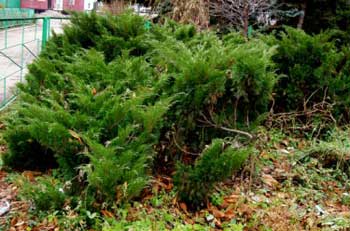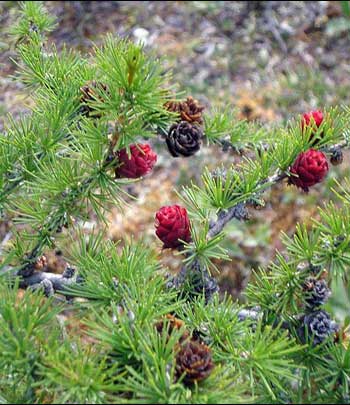Contents:
Common Names | Parts Usually Used | Plant(s) & Culture | Where Found | Medicinal Properties
Legends, Myths and Stories | Uses | Formulas or Dosages | Warning | Bibliography
Scientific Names

- Larix curopaca L.
- Larix americana L.
- Larix laricina L.
- Pinaceae
- Pine family
Common Names
Larix curopaca:
- Common larch
- European larch
Larix americana or Larix laricina:
- Tamarack
- American larch
- Black larch
- Hackmetack
- Salisb
Parts Usually Used
Larix curopaca:
Bark, resin, young shoots, needles
Larix americana or Larix laricina:
Inner bark, gum
Back to Top
Description of Plant(s) and Culture

Larix curopaca:
The common larch is a European tree; it bears light green needles in clusters of 15-20 (fewer on young shoots) and is unusual among members of the pine family in shedding its needles every year. The red or reddish-brown flowers, which emerge in spring before the leaves, are borne in catkins. The scaly cones are bright red when young, turning dark red and finally to chestnut-brown when mature. The cones stay on the tree after the needles have fallen.
Larix americana or Larix laricina:
Black larch or Tamarack is a coniferous tree that grows to 100 feet; Deciduous needles, to 1 inch long in circular clusters. Cones oval, to 3/4 inch long with few scales and are rounded.
Back to Top
Where Found
Larix curopaca:
Grows in mountainous areas and in coniferous forests; in America it is often planted as an ornamental tree.
Larix americana or Larix laricina:
Found in swamps, wet soils from Labrador to West Virginia, northern Illinois; across southern Canada to Alaska (where it is called Latrix alaskensis).
Back to Top
Medicinal Properties
Larix curopaca:
Anthelmintic, diuretic, laxative, vulnerary
Larix americana or Larix laricina:
Alterative, diuretic, laxative, tonic
Back to Top
Legends, Myths and Stories
Larix curopaca:
In European folklore the larch was said to be a preventative against enchantment. The smoke from burning larch bark was thought to drive away evil spirits, and parents had children wear collars of larch bark as a protection against the evil eye.
In Siberia the larch is associated with the primitive shamanistic religion of the native Tungus tribe. According to a shaman interview in 1925, larch poles are used in sacred rites as an earthly representation of the mythical tree called Tuuru, where the souls of all shamen are said to develop before coming to earth. When a tungus shaman practices his art, his soul is symbolically climbing up the Tuuru tree’s larch pole representation, which is said to extend itself invisibly to heaven during the rite. In addition, the shaman’s drum, which he uses to induce his trance, has a rim of larch bark. The actual tree from which this bark is taken is always left standing in honor of the tree Tuuru.
The gummy sap that seeps from the tree has a very good flavor when chewed.
Back to Top
Uses
Larix curopaca:
A cold extract of larch bark has diuretic properties, and the powdered bark can be used on purulent and difficult wounds to promote their healing. A light decoction of fresh needles and young shoots can be added to bath water to make a stimulating bath. Boring into the tree releases resin from which “Venice turpentine” is obtained. In European folk medicine, Venice turpentine is used for innumerable internal and external ailments. Internally, doses of 5-8 drops are taken for tapeworm, bloody diarrhea, sores, and skin problems. It is important to use only small amounts, since even moderate amounts can cause kidney damage internally and swelling blisters externally.
Larix americana or Larix laricina:
Used for jaundice, colic, eyewash, earache, rheumatism, gout, neuralgia, bronchitis, consumption, asthma, constipation, poisonous insect bites, and skin ailments. Gargled for sore throat, sores of the mouth, bleeding gums. Poulticed on sores, ulcers, help overcome the itch, kills nits and lice, swellings, and burns and scalds. Leaf tea is astringent, used for piles, diarrhea, and dropsy; poulticed for burns, abscesses, gangrene, and headaches. Gum is chewed for indigestion.
Back to Top
Formulas or Dosages
Larix curopaca:
Compress: soak a cloth in hot water and wring out. Moisten with a small amount of Venice turpentine and apply to the affected part. Remove after 30 minutes and do not repeat until the next day.
Venice turpentine: for internal use, mix 5-8 drops with honey.
Larix americana or Larix laricina:
Tea: 1 tsp. of the inner bark to 1 cup of boiling water; steep 30 minutes. Take 1/2 cup 4 or 5 times per day.
To treat constipation: buckthorn bark and calamus root are also used; take a tsp. of each and mix with a tsp. of black larch, using the inner bark. Use a heaping tsp. of this mixture to 1 cup boiling water, steep for 30 minutes, and take as much as needed.
Back to Top
Warning
Larix curopaca:
It is important to use only small amounts, since even moderate amounts can cause kidney damage internally and swelling blisters externally.
Larix americana or Larix laricina:
Sawdust of the black larch can cause dermatitis.
Back to Top
Bibliography
![]() American Folk Medicine
American Folk Medicine, by Clarence Meyer, Meyerbooks, publisher, PO Box 427, Glenwood, Illinois 60425, 1973
![]() Back to Eden
Back to Eden, by Jethro Kloss; Back to Eden Publishing Co., Loma Linda, CA 92354, Original copyright 1939, revised edition 1994
![]() Eastern/Central Medicinal Plants
Eastern/Central Medicinal Plants, by Steven Foster and James A. Duke., Houghton Mifflin Company, 215 Park Avenue South, New York, NY 10000
![]() The Herb Book
The Herb Book, by John Lust, Bantam Books, 666 Fifth Avenue, New York, NY. copyright 1974.
 How Indians Use Wild Plants for Food, Medicine & Crafts
How Indians Use Wild Plants for Food, Medicine & Crafts, by Frances Densmore, Dover Publications, Inc., 180 Varick Street, New York, NY 10014, first printed by the United States Government Printing Office, Washington, in 1928, this Dover edition 1974
![]() Indian Herbalogy of North America
Indian Herbalogy of North America, by Alma R. Hutchens, Shambala Publications, Inc., Horticultural Hall, 300 Massachusetts Avenue, Boston, Massachusetts 02115, 1973
![]() The Nature Doctor: A Manual of Traditional and Complementary Medicine
The Nature Doctor: A Manual of Traditional and Complementary Medicine, by Dr. H.C.A. Vogel; Keats Publishing, Inc., 27 Pine Street (Box 876) New Canaan, CT. 06840-0876. Copyright Verlag A. Vogel, Teufen (AR) Switzerland 1952, 1991
![]() Webster’s New World Dictionary
Webster’s New World Dictionary, Third College Edition, Victoria Neufeldt, Editor in Chief, New World Dictionaries: A Division of Simon & Schuster, Inc., 15 Columbus Circle, New York, NY 10023
